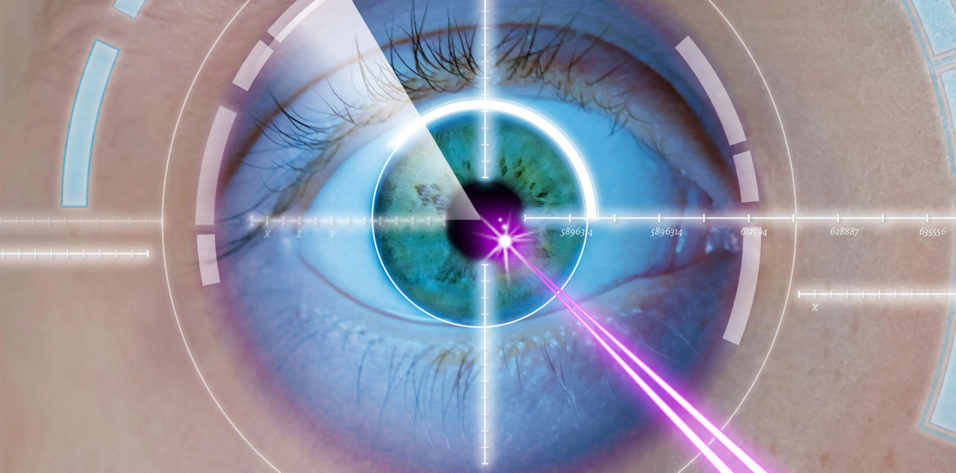An Excimer Laser Procedure Is Preferred, With Status of the Ocular Surface Determining Which One

BY TIAGO MONTEIRO, MD, FEBO, FEBOS-CR
Phacoemulsification with multifocal IOL implantation has become the main refractive procedure for patients with presbyopia who are seeking spectacle independence. To obtain an excellent refractive and visual result, several requirements must be met during the pre-, intra-, and postoperative periods. Emmetropia after IOL implantation is crucial to obtain a good visual outcome; however, despite the major advances in IOL formulas and preoperative measurements, an unintended postoperative refractive error cannot always be avoided.
Common causes of undesired refractive error after multifocal IOL implantation include inaccuracies in preoperative measurements or biometric calculations, discrepancies among formulas and estimated lens position calculations, and postoperative IOL mispositioning (decentration, tilt, or axial displacement) due to anatomic discrepancies between the IOL geometry and the capsular bag or to improper surgical technique.
Astigmatism correction during cataract or refractive lens exchange is part of the refractive treatment. Astigmatism, together with dry eye disease (DED), is one of the main causes of patient dissatisfaction after cataract surgery with multifocal IOLs,1 and it is the main refractive error treated with excimer laser after multifocal IOL implantation.2,3
SURGICAL OPTIONS FOR IOL ENHANCEMENT
Surgical treatments available for the enhancement of visual results with implanted IOLs include excimer laser surgery, astigmatic keratectomy, IOL exchange, and implantation of a piggyback IOL. In general, residual refractive errors after surgery are of low magnitude (spherical equivalent < 1.50 D). Low ametropia is clearly an indication for excimer laser surgery.4-7 It is rarely necessary to perform IOL exchange or implant a piggyback IOL; however, the need for either one could occur for two reasons: (1) the patient has a corneal contraindication for laser vision correction or (2) the residual refractive error magnitude is very high.
Normally, corneal topography is mandatory in preoperative patient evaluation for a multifocal IOL. One of the reasons is that corneal topography enables the surgeon to confirm that excimer laser surgery could be performed, if needed, in that patient. A basic rule of thumb is that one should never implant a multifocal IOL in a patient whose cornea would not be suitable for excimer laser enhancement.
In choosing which type of excimer laser surgery to perform, I take into consideration the type of refractive error, the status of the ocular surface, and the professional needs and recovery time available for each patient.
LASIK OR PRK
LASIK is typically my preferred option when the patient requires fast visual recovery, when the ocular surface is intact, or when the refractive error is mainly astigmatism. I choose PRK if the refractive error is mainly sphere, if the ocular surface is compromised, or if the patient has symptoms of DED.
Patients undergoing refractive lens exchange are typically older than 50 years, and most are females—a population among whom the prevalence of DED or ocular surface disease (OSD) is high. In this clinical scenario, it is advisable to treat the ocular surface before performing excimer laser surgery. Detailed informed consent is necessary, especially in asymptomatic patients with signs of OSD such as blepharitis or meibomian gland dysfunction. At least 3 months of therapy with ocular lubricants, heat, palpebral massage, omega-3 fatty acid oral supplements, and intense pulsed light therapy is typically mandatory before proceeding with surgery. PRK is associated with less induction of DED symptoms than LASIK; however, it can require a longer reepithelialization period due to age-related decrease in the healing response.
Schallhorn et al compared the clinical results of LASIK and PRK for enhancement after multifocal IOL implantation. These authors did not find any clinically significant differences between the techniques in terms of efficacy and safety.8
SMILE
SMILE is a relatively new corneal surgery performed with a femtosecond laser. The efficacy and accuracy of this lenticule-based procedure has not yet been validated in eyes with very low spherical equivalent errors. Additionally, outcomes following SMILE for astigmatism correction are worse than outcomes with excimer laser procedures.9
The great advantage of using SMILE in an older population would be a reduced induction of DED symptoms and OSD. However, this surgical technique must evolve to achieve efficacy similar to that of LASIK and PRK in eyes with astigmatism or low ametropia. For these reasons, SMILE is not currently an option for multifocal IOL refractive enhancement in my practice.
CONCLUSION
Significant ametropia after multifocal IOL implantation can have an adverse effect on the refractive and visual outcomes of surgery. Due to the typically low magnitude of these refractive errors, excimer laser surgery is usually my first treatment of choice, especially because it is a refractive procedure with outstanding results and proven accuracy and efficacy. The choice between LASIK or surface ablation depends on the characteristics of a given patient, the status of his or her ocular surface, and the presence of DED.
1. de Vries NE, Webers CA, Touwslager WR, et al. Dissatisfaction after implantation of multifocal intraocular lenses. J Cataract Refract Surg. 2011;37(5):859-865.
2. Hayashi K, Manabe S, Yoshida M, Hayashi H. Effect of astigmatism on visual acuity in eyes with a diffractive multifocal intraocular lens. J Cataract Refract Surg. 2010;36(8):1323-1329.
3. Hayashi K, Hayashi H, Nakao F, Hayashi F. Influence of astigmatism on multifocal and monofocal intraocular lenses. Am J Ophthalmol. 2000;130(4):477-482.
4. Kuo IC, O’Brien TP, Broman AT, Ghajarnia M, Jabbur NS. Excimer laser surgery for correction of ametropia after cataract surgery. J Cataract Refract Surg. 2005;31(11):2104-2110
5. Jendritza BB, Knorz MC, Morton S. Wavefront-guided excimer laser vision correction after multifocal IOL implantation. J Refract Surg. 2008;24(3):274-279.
6. Alfonso JF, Fernández-Vega L, Montés-Micó R, Valcárcel B. Femtosecond laser for residual refractive error correction after refractive lens exchange with multifocal intraocular lens implantation. Am J Ophthalmol. 2008;146:244-250.
7. Muftuoglu O, Prasher P, Chu C, et al. Laser in situ keratomileusis for residual refractive errors after apodized diffractive multifocal intraocular lens implantation. J Cataract Refract Surg. 2009;35(6):1063-1071.
8. Schallhorn SC, Venter JA, Teenan D, et al. Outcomes of excimer laser enhancements in pseudophakic patients with multifocal intraocular lens. Clin Ophthalmol. 2016;10:765-776.
9. Alió Del Barrio JL, Vargas V, Al-Shymali O, Alió JL. Small incision lenticule extraction (SMILE) in the correction of myopic astigmatism: outcomes and limitations – an update. Eye Vis (Lond). 2017;15;4:26.
LASIK Is the Preferred Approach for Premium IOL Patients Who Require Enhancements

BY ALLON BARSAM, MD, MA, FRCOphth
My first-line method of choice for enhancing premium IOLs is LASIK, as long as the ocular surface is reasonably healthy. If the ocular surface is not optimized and we believe we can improve it, we often treat the patient’s ocular surface first, before carrying out the LASIK. If the patient had a highly hyperopic or a very highly myopic refractive correction, I would choose an alternative enhancement method, but those conditions are fairly rare.
PRK IN LIMITED SCENARIOS
If the degree of residual refractive correction required is very small and the ocular surface is not 100% healthy, PRK is likely to be more sparing to the cornea and cause less dryness than LASIK. If the patient’s residual error is very small and without much astigmatism—for example, -1.00 D or less of spherical error and less than 0.50 D of astigmatism—I may opt for PRK.
NO SMILE
I don’t perform SMILE at the moment because I am concerned about the fact that there is no way to track the mesopic pupil edge, control for pupil centroid shift, avoid parallax when applying the laser cone, or, currently, accurately align and correct astigmatism. Additionally, SMILE has not been shown to achieve superior outcomes for low refractive errors compared with outcomes achievable with LASIK or PRK. I don’t think SMILE is a helpful enhancement procedure unless the patient’s residual refractive error is quite significant.
PATIENT PERCEPTIONS
I assess each patient’s acceptance of the proposed treatment option because these are premium lens patients who are, by definition, not happy with their outcomes. Some patients will accept the slightly prolonged and potentially more painful recovery after PRK compared with LASIK, and some will not. For this reason, I am not totally prescriptive when I recommend a surface procedure rather than LASIK. I’m guided by the patient.
At other times—for instance if I’m more worried about the ocular surface than I am about the patient’s perception of the treatment—I will more forcefully recommend a surface procedure over LASIK.
In a patient who is already unhappy with his or her outcome—as any patient presenting for an enhancement is—I generally prefer LASIK because it is essentially painless and because the visual outcomes and recovery are essentially instantaneous.
OTHER OPTIONS
If the residual refractive error is low and for some reason we can’t do LASIK, my next choice would be implanting a piggyback Sulcoflex Pseudophakic Supplementary IOL (Rayner).
This choice depends on the magnitude of the refractive error and the anatomy of the patient’s anterior chamber. If there is no Sulcoflex IOL adequately powered to correct the refractive error, another option is needed.
Additionally, if the anterior chamber is small, I would be concerned about the eye being able to accommodate a supplementary lens. Therefore, if the refractive error or condition of the ocular surface precluded laser, my treatment option of choice would be IOL exchange. The difficulty with an IOL exchange is that one doesn’t always know the power of the lens that was initially implanted. The other options previously mentioned are preferable to this, in my opinion.
Careful Examination of the Tear Film and Ocular Surface Is a Must Before Any Enhancement


BY JOHNNY MOORE, MD; AND RICHARD MCNEELY, BSC, PHD, MCOPTOM
Prior to laser vision correction to enhance the result achieved with a premium IOL, we take a detailed ocular history and conduct a full ophthalmologic investigation, which includes a clinical examination, corneal topography, and both anterior and posterior OCT imaging. This information can influence our management of each patient.
Initially, we consider whether it is appropriate to perform an enhancement based on the patient’s symptoms. Patients should not be treated on the basis of residual refractive error alone. If they are symptomatic, we allow them additional time—often 2 to 3 months—for neural adaptation and refractive stability. If we then deem treatment to be appropriate based on the patient’s reported quality of vision, several factors require careful consideration.
PREOPERATIVE CONSIDERATIONS
Refractive error. Myopic eyes can be treated with PRK, LASIK, or SMILE. For a patient with a healthy eye who requires earlier intervention, I (JM) would perform either a PRK or LASIK enhancement. Residual hyperopia or hyperopic astigmatism require treatment with either LASIK or PRK. In these cases, I generally prefer LASIK due to the speed of recovery but will perform PRK if other corneal issues are detected.
Because of the procedure’s many advantages, SMILE would be my choice for a healthy eye with residual myopic error of greater than 0.75 D if there were no time constraints. Advantages include a reduced effect on the corneal nerves and the subsequent preservation of the tear film,1 which is often mildly compromised in older patients; additional biomechanical advantages; safety because of no flap creation; and speed of recovery.2,3 I would allow 6 months to elapse after the initial IOL implantation to avoid disturbing the cataract incisions.
Tear film and ocular surface. Whichever enhancement procedure is selected, a careful examination of the tear film and ocular surface is required. If a reduced tear film is observed, aggressive management of the ocular surface is necessary to optimize the chances of uneventful recovery after laser treatment. Management may include antiinflammatories, antibiotics, physical lid massage, and intense pulsed light.4 If no significant improvement occurs, the best option may be not to perform an enhancement at all. SMILE is particularly advantageous in older patients following IOL surgery, as a reduced tear film is more common in this patient population. I try to avoid PRK in older patients (> 70 years) with a substandard tear film because of its effect on the tear film; I have heard of anecdotal cases of poor healing and scarring.
Corneal topography. This diagnostic test is essential in deciding on which laser enhancement procedure to perform. Patients may have a history of laser vision correction, trauma, or corneal infection. SMILE is not appropriate for those with corneal problems or significant higher-order aberrations (HOAs), but both PRK and LASIK are options.
I would select PRK for patients with epithelial basement membrane dystrophy or other irregularity to the epithelium or epithelial basement membrane. In patients with recurrent erosion syndrome or epithelial basement membrane dystrophy, alcohol debridement can be performed to remove the irregular epithelium, followed by PRK. I find that a transepithelial approach using the Amaris excimer laser (Schwind eye-tech-solutions) facilitates the use of epithelial masking to improve PRK results in eyes with stromal irregularities such as corneal scars. In the presence of corneal abnormalities as outlined above, I would not use multifocal IOLs, but would still use premium monofocal IOLs—both toric and nontoric.
Topography-guided LASIK or PRK can correct HOAs caused by previous refractive surgery.
deciding What LVC procedure is best
When PRK is best. PRK is effective for the treatment of residual refractive error,5,6 but it is best reserved for patients who have an associated corneal issue such as epithelial irregularity; epithelial basement membrane irregularity; or anterior stromal irregularity, including HOAs induced by previous corneal refractive surgery. I would use transepithelial PRK for eyes with corneal stromal irregularities. PRK is also appropriate for patients with normal corneas and a healthy tear film if early corrective surgery is required, and it can be used in a transepithelial mode even for low levels of refractive error by increasing the optical zone.
When LASIK is best. LASIK is well known to be safe and effective for the treatment of myopia, hyperopia, and astigmatism after cataract surgery.7,8 One key advantage of this procedure is the painless and rapid recovery, and it is for this reason that I perform LASIK to enhance outcomes in premium IOL patients with any residual refractive error who have a healthy tear film and require rapid surgical recovery. LASIK can be performed in patients who have a mildly reduced tear film following optimization and thorough patient counseling. We generally wait at least 4 months after IOL surgery to perform a LASIK enhancement.
When SMILE is best. SMILE surgery has clear advantages in protecting the ocular surface. If a patient can wait the required 6 months for an enhancement, I would perform SMILE to correct residual myopia if the refractive error is greater than 0.75 D. For lower levels of refractive error, I would use one of the other laser modalities. A period of ocular surface optimization may be required if the tear film is reduced.
When to Avoid Laser Vision Correction
If a patient does not respond to tear film management, I generally do not pursue a refractive surgery enhancement so as not to exacerbate dry eye disease. It is very important to counsel patients properly in these circumstances and to discuss other options, such as IOL exchange. (Editor’s note: For more on the topic of IOL exchange, see “IOL Exchange or Piggyback,” by Asim R. Piracha, MD; and David A. Goldman, MD.)
For any patient potentially undertaking further laser vision correction following premium IOL surgery, preoperative counseling is essential to ensure that he or she understand the potential side effects, which include dry eye and continued dysphotopsias from multifocal IOLs.
1. Denoyer A, Landman E, Trinh L, et al. Dry eye disease after refractive surgery: comparative outcomes of small incision lenticule extraction versus LASIK. Ophthalmology. 2015;122(4):669-676.
2. Wang B, Zhang Z, Naidu RK, et al. Comparison of the change in posterior corneal elevation and corneal biomechanical parameters after small incision lenticule extraction and femtosecond laser-assisted LASIK for high myopia correction. Cont Lens Anterior Eye. 2016;39(3):191-196.
3. Yu M, Chen M, Dai J. Comparison of the posterior corneal elevation and biomechanics after SMILE and LASEK for myopia: a short- and long-term observation. Graefes Arch Clin Exp Ophthalmol. 2019;257(3):601-606.
4. Albietz JM, Schmid KL. Intense pulsed light treatment and meibomian gland expression for moderate to advanced meibomian gland dysfunction. Clin Exp Optom. 2018;101(1):23-33.
5. Fan YY, Sun CC, Chen HC, Ma DH. Photorefractive keratectomy for correcting residual refractive error following cataract surgery with premium intraocular lens implantation. Taiwan J Ophthalmol. 2018;8(3):149.
6. Sáles CS, Manche EE. Managing residual refractive error after cataract surgery. J Cataract Refract Surg. 2015;41(6):1289-1299.
7. Kim P, Briganti EM, Sutton GL, et al. Laser in situ keratomileusis for refractive error after cataract surgery. J Cataract Refract Surg. 2005;31:979-986.
8. Kuo IC, O’Brien TP, Broman AT, et al. Excimer laser surgery for correction of ametropia after cataract surgery. J Cataract Refract Surg. 2005;31:2104-2110.


